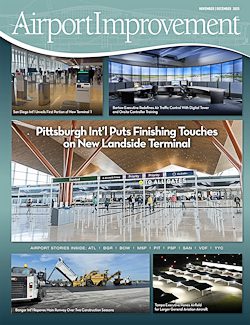 |
|
Facts & Figures Project: Perimeter Security Enhancement Location: DuPage Airport, West Chicago, IL Cost: $1.7 million Project Timeline: Approximately one year from design to operation Prime Contractor: Video & Sound Services Design Consultant: Reynolds, Smith & Hills Wireless Installation: WAV Wireless Outfitters Data/Video Surveillance Network: Azalea Networks Fencing Contractor: Peerless Fence Gates: Tymetal Corp. Project Details: More than 10,000 feet of eight-foot fencing and approximately 22 access-controlled gates were installed. Wireless network syncs video with gate access and operation. |
Executive director David Bird describes it this way: “Before installing this security system, pedestrian access to the airport was virtually uncontrolled and vehicular access was controlled very loosely. Today, we believe we have one of the best security systems of any general aviation airport in the country.”
Increasing Security
The airport-funded project targeted perimeter control by replacing approximately two miles of four-foot fencing with eight-foot fencing. About ten new pedestrian gates and a dozen new vehicle gates are controlled by an electronic security system that integrates access control and closed circuit television (CCTV) monitoring, covering nearly the entire airfield.
John Barclay, senior project manager for prime contractor Video & Sound Services, describes security before the project as “loose at best.”
“Pedestrian gates were open and anyone could walk through,” Barclay recalls. “Although the vehicle gates were not open, tenants were given what, in effect, were garage door openers. The airport had no control over whose opener was opening what gate.”
Today, tenants access all pedestrian gates and most vehicle gates by presenting their badge to a proximity card reader and keying in assigned pin numbers. Select vehicle gates are controlled by a remote device that is individually assigned.
WAV Wireless Outfitters installed the wireless data and video surveillance network that integrates video cameras with vehicle and pedestrian access gates, which are monitored at several locations throughout the airport. The previous system required a physical visit to the gate location to update access parameters, and gates were monitored by analog video cameras.
The interesting thing about wireless mesh broadband connectivity, relates WAV vice president Tim Strueber, is that the nodes are able to relay information to each other. “This accomplishes a couple of things,” explains Strueber. “If there’s no line of sight to the head end of the network, you can bounce information through the various relay points. Also, connectivity offers reliability. If a node were to fail, information is routed around it automatically to another node and eventually to the head end. It’s built for resiliency and redundancy.”
 |
 |
 |
 |
 |
 |
Fencing & Gates
With 60+ vehicle gates and 40+ pedestrian gates, the airport’s former four-foot perimeter had far too many access points to the airfield. During its design consultation, RS&H worked with airport personnel to reduce the number of vehicle gates by 25% and pedestrian gates by 71%.
“We spent a lot of time looking at gate locations to determine whether tenants were using them,” Butler explains. “We also had to determine how eliminating a gate would impact operations. We went out with maintenance and operations staff to make sure that fuel trucks and snowplows, for example, could make the necessary turns in and out of gates.”
Peerless Fence installed the black vinyl-coated fencing and 16-foot-wide powder coated Tymetal gates. The gates are powered by rail-driven HySecurity Gate Operators, which had been newly installed in the last few years. In the grass area, a one-mile mow strip was dug out and filled with stone to inhibit weed growth against the fence and prevent mowers from damaging the new fence.
According to Tim Ford of Peerless, crews had to dig down more than four feet for adequate footing. They also relocated more than 100 yards of dirt from the post holes to elsewhere on airport grounds.
Gate sizes were standardized to facilitate installation and future maintenance. The airport requested that Tymetal gates be installed because the manufacturer’s four-foot gates that were installed in the early 1980s had held up well.
Throughout the three-month fence installation, Peerless coordinated its work with Video & Sound so no more than one gate would be out of commission at any given time. When a gate was removed, Peerless had it up and running the next day.
Reassuring Tenants
Although officials felt it was important to limit and monitor access to airport facilities, they were also somewhat concerned about moving from minimal security to high security in one fell swoop.
|
Tim Ford |
“There have been very few problems other than people forgetting their pin number,” Bird relates. “And even that has diminished over time. All in all, the new system is working very well, and we’re very pleased.”
The project also spawned plans for future perimeter enhancements. According to Bird, the airport will likely replace all of its existing six-foot fences with eight-foot fences in the next few years. A skirt may also be added to the bottom of the fences to prevent animals from digging underneath and gaining access to the airfield.
 |



